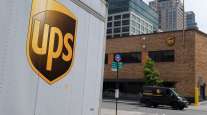UPS Raises 2Q Net Income on Higher Package Volume

This story appears in the Aug. 8 print edition of Transport Topics.
UPS Inc. boosted net income in the second quarter by 3.2% to $1.27 billion, or $1.43 per share, helped by internal company improvements as well as stronger international and domestic package profitability.
The Atlanta-based company’s July 29 report stressed its success in overcoming choppy freight markets through steps such as sorting capacity increases, enhanced tracking, added pickup locations and its package-routing technology. Domestic package volume, for example, climbed 2.5%, even though miles driven fell 0.3%.
“We’re seeing a nice balance,” Chief Financial Officer Richard Peretz said. “Our volume does have some correlation, especially when you get to [business-to-business], to what’s happening with both domestic GDP, things like industrial production and things like that. They all have softened somewhat from first quarter to second quarter.”
Peretz added, “The other side of it is what’s happening internally. We’re making up for some softness externally with what we’re doing internally. That’s allowed us to grow our earnings per share for six quarters in a row.”
Profit before interest and taxes rose 2.7% to $1.2 billion at the domestic package unit, reflecting 2.5% volume growth that was helped by e-commerce. Growth in Europe helped international package profitability to rise 11% to $613 million, which was the sixth straight quarter of growth topping 10% at that unit. Supply chain and freight business lagged, with a 15% decline in profitability, year-over-year, to $192 million, hurt by the weak market in freight forwarding and the less than-truckload sector.
UPS improved revenue 3.8% to $14.6 billion. Earnings in last year’s second quarter were $1.23 billion, or $1.35 per share.
U.S package revenue climbed 2.4% to $9 billion. International revenue rose 1.1% to $3.1 billion, led by more than 10% improvement in the Europe-to-U.S. market. Supply chain and freight revenue was 13% higher at $2.54 billion, helped by the acquisition of Coyote Logistics.
At Supply Chain and Freght, distribution and truckload brokerage performed better than other parts of that division. The LTL unit’s tonnage fell 10%, but revenue per 100 pounds of freight was 2.9% higher.
LTL revenue was $600 million, down 7.3%. UPS Freight’s truckload revenue declined 11.5% relative to the same time in 2015.
Chief Commercial Officer Alan Gershenhorn said LTL pricing continues to be firm even though volume declined.
William Blair & Co. analyst Nate Brochmann said UPS shouldn’t experience much effect from growing Amazon package deliveries because “UPS’ network and large customer base allow it to generate the density necessary to make e-commerce deliveries profitable. We do not believe that Amazon or any other retailers would be able to generate that same level of density on their own, except in some large urban areas.”
Domestically, Next-Day Air revenue rose 2.9%, outpacing Deferred and Ground. Ground comprised 70% of domestic package revenue and nearly 90% of total shipments.
UPS forecast continued international profit improvement, while scaling back its expectations for international airfreight and domestic trucking.




